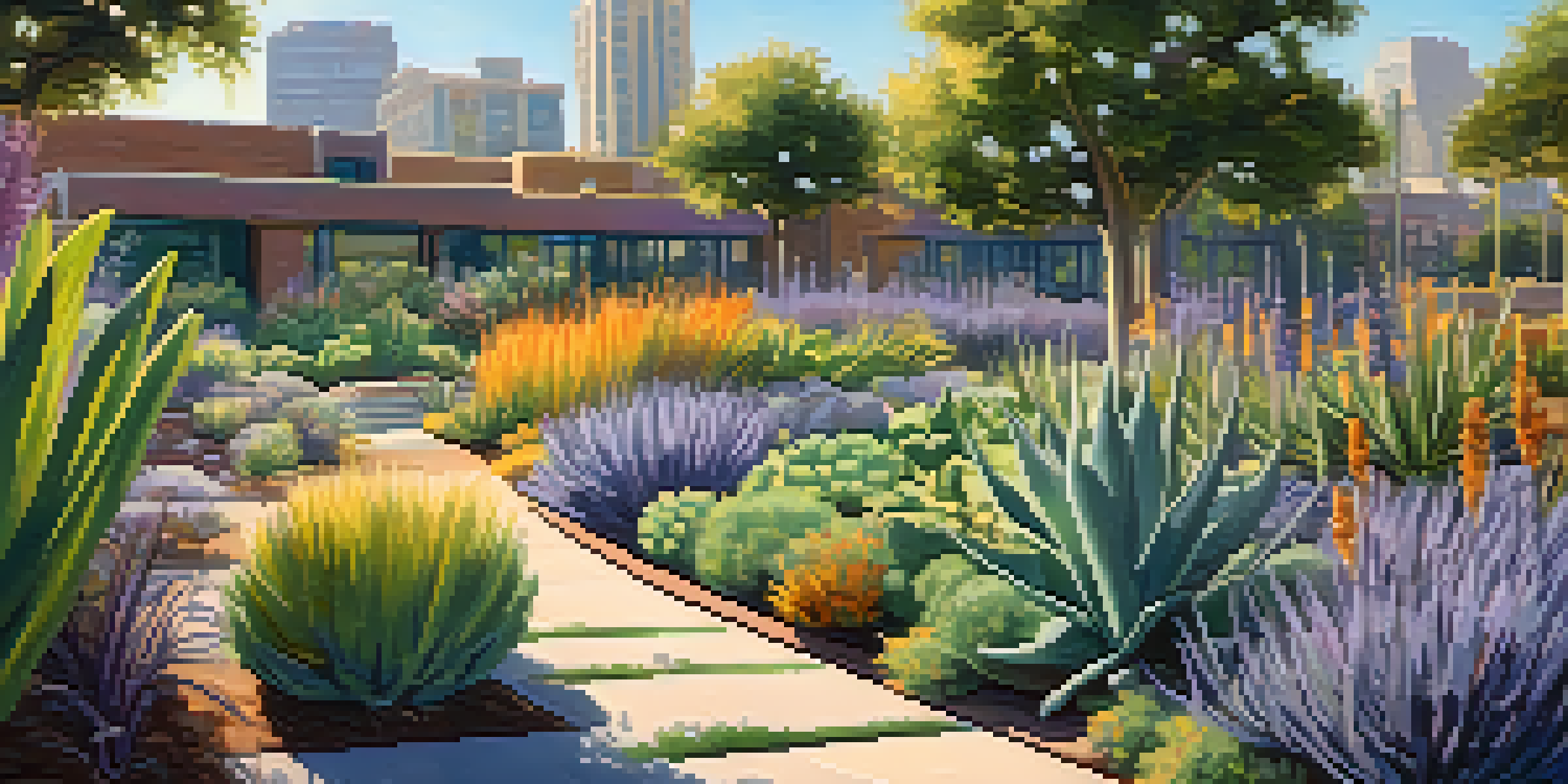Using Drought-Resistant Plants in Urban Climate Adaptation

Understanding Drought-Resistant Plants and Their Benefits
Drought-resistant plants, often termed xerophytes, are species adapted to survive with minimal water. They possess unique traits like deep roots or thick, fleshy leaves that store moisture. By incorporating these plants into urban landscapes, cities can reduce water consumption while maintaining aesthetics and biodiversity.
In nature, nothing exists alone.
One significant advantage of these plants is their ability to thrive in challenging conditions, which can help mitigate the impacts of climate change. For instance, using drought-resistant species in gardens and parks can ensure that these green spaces continue to flourish even during prolonged dry periods. This not only beautifies urban areas but also supports local wildlife.
Moreover, planting drought-resistant species can significantly lower maintenance costs for city governments and homeowners alike. Fewer watering demands mean lower utility bills and reduced labor for landscape upkeep, making it a win-win for both the environment and the budget.
The Role of Drought-Resistant Plants in Urban Ecosystems
Urban ecosystems face unique challenges, including heat islands and stormwater runoff. Drought-resistant plants contribute positively by improving soil quality and increasing biodiversity. This helps create a more resilient ecosystem that can better withstand climate extremes.

For example, native drought-tolerant plants like lavender or succulents not only require less water but also attract pollinators, which are crucial for healthy ecosystems. The buzz of bees and flutter of butterflies add vibrancy to our urban spaces, reminding us that even in concrete jungles, nature can thrive.
Benefits of Drought-Resistant Plants
Drought-resistant plants reduce water consumption, lower maintenance costs, and enhance urban biodiversity.
Additionally, these plants can assist in managing stormwater runoff. Their deep root systems can help absorb excess rainwater, reducing flooding risks and promoting groundwater recharge. This natural form of water management is essential for sustainable urban living.
Selecting the Right Drought-Resistant Plants for Your Area
Choosing the right drought-resistant plants starts with understanding your local climate and soil conditions. Native species are often the best choice, as they are already adapted to the local environment and require minimal care. Researching local flora can help in selecting plants that will thrive with little water.
The best time to plant a tree was 20 years ago. The second best time is now.
For instance, in arid regions, plants like agave or yucca may be ideal, while in more temperate climates, you could look at sage or ornamental grasses. Consulting with local nurseries or extension services can provide valuable insights into which plants will suit your needs best.
Also, consider the purpose of your planting. Are you looking to create a vibrant garden, or do you need a low-maintenance landscape? By defining your goals, you can make more informed decisions and create a space that meets both your aesthetic desires and water conservation needs.
Integrating Drought-Resistant Plants into Urban Design
Urban design can greatly benefit from the integration of drought-resistant plants, making cities both beautiful and sustainable. Incorporating these plants into parks, sidewalks, and public spaces enhances the overall landscape while addressing water scarcity. This approach aligns with modern sustainable urban planning principles.
For instance, installing green roofs with drought-tolerant plants not only provides insulation but also helps manage stormwater effectively. These green spaces can transform rooftops into lively ecosystems, promoting biodiversity even in densely populated areas.
Selecting Suitable Plants Matters
Choosing native drought-resistant species ensures better adaptation to local climates and soil conditions.
Moreover, utilizing drought-resistant plants in public art installations or community gardens encourages local engagement with nature. It fosters a sense of community pride and awareness about sustainable practices, inspiring residents to adopt similar approaches in their own gardens.
Building Community Awareness Around Drought Resilience
Educating the community about the benefits of drought-resistant plants is crucial for fostering a culture of sustainability. Workshops, community gardens, and local events can serve as platforms for sharing knowledge about water conservation and plant selection. Through these initiatives, residents can learn how to incorporate these plants into their own spaces.
Stories and testimonials from community members who have successfully transitioned to drought-resistant landscaping can inspire others. When people see tangible results, like reduced water bills or thriving gardens, they are more likely to make similar changes in their own lives.
Social media can also be a powerful tool for spreading awareness. Sharing photos of beautiful drought-resistant gardens or innovative urban designs can spark interest and motivate others to participate in the movement towards sustainable urban ecosystems.
Challenges and Considerations for Urban Drought Adaptation
While the benefits of drought-resistant plants are clear, there are challenges to consider in urban environments. Soil quality, existing plant communities, and local wildlife can all impact the success of new plantings. Therefore, it’s essential to conduct thorough assessments before implementation.
Additionally, there can be a perception challenge; some people may view drought-resistant plants as unattractive or uninviting. Overcoming these misconceptions requires showcasing the beauty and diversity of these plants through design and education.
Community Engagement is Key
Building community awareness through education and local events fosters a sustainable culture around drought resilience.
Lastly, ongoing maintenance and care are essential for ensuring the long-term success of drought-resistant landscapes. Regular monitoring can help identify any issues early, enabling timely interventions that keep these green spaces thriving.
Future Trends in Urban Drought-Resistant Landscaping
As climate change continues to affect urban areas, the trend toward using drought-resistant plants is likely to grow. Innovations in landscaping technology and sustainable practices will pave the way for greener cities. The future may see more integrated designs that combine ecological principles with aesthetic appeal.
Urban planners are increasingly recognizing the value of nature-based solutions, which include the use of drought-resistant plants. This shift indicates a broader movement towards creating urban environments that prioritize resilience and sustainability.

Moreover, advancements in plant breeding and genetic research may lead to the development of even more drought-tolerant varieties. As these options become available, urban landscapes will have even more tools at their disposal to adapt to changing climate conditions.